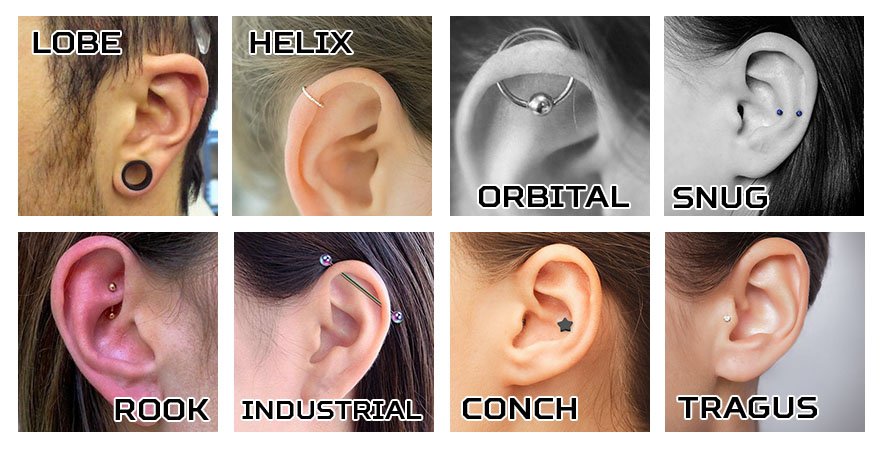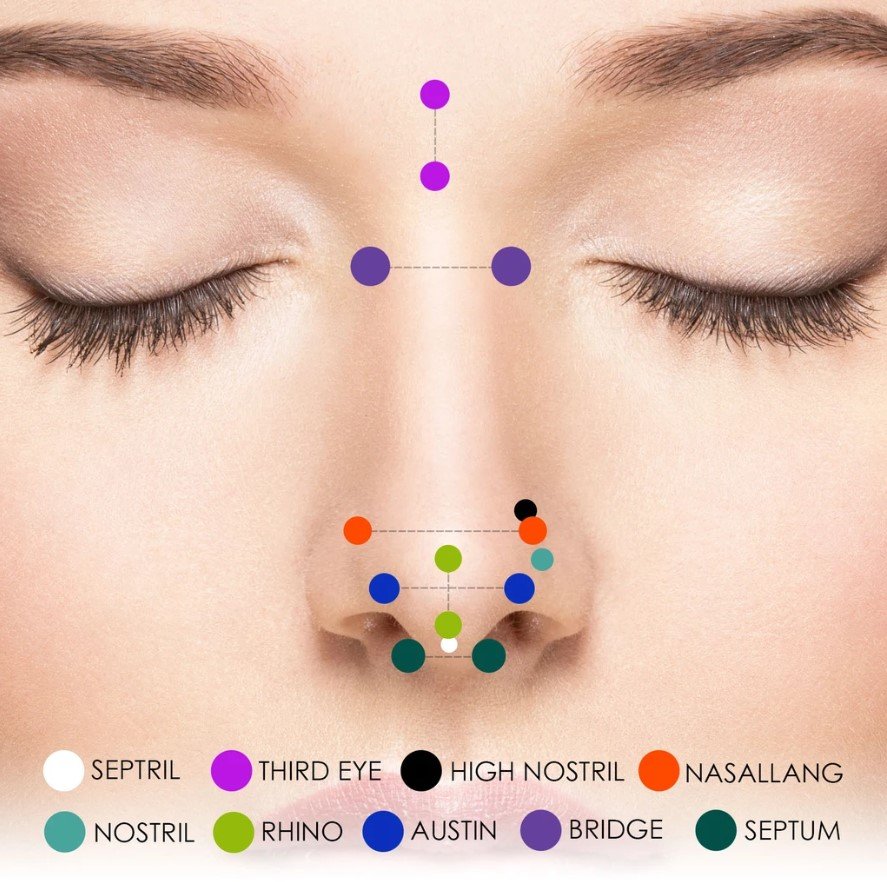Ear, Nose, Tongue & Lips Piercing Guide
In today’s society, self expression has become a truly experimental art form that’s stemmed from many different cultures, beliefs and ages of bodily progression. One of the biggest and longest running form is piercing. Piercings can define a person’s ideals, character and even group affiliations and their commitment to being self aware and integrated into a community.
We will be discussing a few topics on the popularity of piercings, the many types available, their meanings, health benefits, personal motivations and aftercare.
As far back as 5,000 years ago, the piercing of ears have been found to have existed. Even the piercing of the nose dates back to 1500 BC. Though there are many types of piercings available today, the ears, nose, tongue, lips and eyebrows have been the most widespread and popular body modification practices to date. There are, however, other piercings such as the navel, nipples, genital and dermal, but that’s for another conversation.
For this article we will focus on the ears, nose, tongue and lips.
Ear Piercings
As mentioned before, the piercing of ears has been dated back to over 5,000 years and has been the most progressive area of body modification overall. The piercing of one’s ears has many different meanings throughout time. Everything from showing one’s wealth and power, to being placed on slaves whom wished not to be freed in biblical times, though most were to adorn the ears as beauty.
Expanding from the simple lobe, throughout the entire cartilage, stretching of the lobes and even hollowing out portions of the cartilage sections depending on the religious or committed act of doing so. Some people have even received piercings to help fight migraines and body aches by piercing their daith, though it has not been proven to be 100% effective to date.
Here’s a list of available piercings one can receive on their ear:
- Lobe – pierced through the tissue with a single needle and often gauged to bigger sizes.
- Helix – the piercing of the outer upper ear and comes in single, double, triple and more.
- Orbital – having two piercing spots connected with one piece of jewelry.
- Snug – a piercing that is done on the antihelix of the ear.
- Rook – an antihelix piercing done in the inner part of the ears cartilage.
- Industrial – connects two holes with one bar, usually through the cartilage.
- Conch – a cartilage piercing usually from within the ear that may loop to the outside.
- Tragus – the cartilage right above the lobe. Some aim for curing headaches with this piercing.
There are a few more types and locations of piercings, but we chose to highlight these popular choices that people tend to get more often.

Nose & Septum Piercings
Although new to the western world, nose piercings have long since been around for thousands of years in Africa, India and the Middle East. The nose piercing is the second most popular piercing in the world, right behind the ear.
Piercing of the nose in the West used to be a sign of defiance and rebellion, whereas in places like India shows a symbol of significance, wealth or prestige and a great beauty accessory.
Places to get pierced on the nose include:
- Nostrils – Single or double hole fitted with a ring loop or stud.
- Septum – Pierced through the soft tissue below the cartilage between each nostril.
- Bridge – Also called the “Earl” or “Erl” is done on the uppermost part of the nose and not through the bone or cartilage. If done vertical it is often referred as the “Third Eye”.
- Nasallang – Going from one side of the nose to the other and going through the septum cartilage. Fitted with a single barbell.

Tongue Piercings
Coming in at number 3 of most popular types of piercings is the tongue. Prone to the highest area of infection, this isn’t a modification to take lightly.
Here are the most popular types of the tongue to get:
- Midline – The most casual form of piercing to get. It’s done in the midline of the tongue, going from the bottom to the top, fitted with a single barbell.
- Frenulum Linguae (Web) – Underneath the tongue is a “web” of connective tissue called the frenulum linguae. A single piercing done horizontally and a ring or short barbell is used.
- Venom – A double piercing of both sides of the tongue placed next to one another, creating a “snake bite” look.
- Vertical – When the top of the tongue flesh is pierced from front to back using a single barbell.
Lip Piercings
When it comes to piercing the lips (orbicular muscles) there are a multitude of popular piercing styles and options. Though many places in the world have had the style of the labret, found in places like Papua New Guinea and the Amazon basin, the western culture has expanded other types.
Types of globally popular lip piercings:
- Bottom Lip – A single piercing accented with either a ring or stud on either side of the bottom lip.
- Labret – A single piercing under the bottom lip located in the center.
- Monroe – Above the top lip off to one side with a stud, meant to mimic the mole Marilyn Monroe had.
- Medusa – Like the Labret but on the upper lip, located in the center.
- Vertical Labret – This is a double piercing, going from the below the bottom lip, through the lip itself and fitted with a barbell.
- Dahlia – A double piercing, located not on the lips themselves, but to the sides of the lips, studs or small jewels are used.
- Snake Bites – Double piercings through both sides of the bottom lip, to represent the fang bites of a snake.
- Angel Bites – Like the Snake Bites, but above the top of the upper lip.

Where to Get Piercings
When seeking an establishment or artist to do your piercing(s), it’s very important to make sure that the location has a good reputation for cleanliness and reviews. Some shops will advertise all kinds of piercing options at low cost in comparison to other places, so be sure to do your research on them before making a commitment. In most cases, places that have lower prices are just trying to get clientele in the door and aren’t always looking to provide them with a safe and hazard free environment.
Differences in professional and amateur shops are their handling and care of the shops overall care. If you notice a lack in cleanliness such as overflowing garbage bins, food wrappers around the counters or waiting areas (food and drink must be located in an area away from equipment that is used for sterilization and prepping), dirty and unclean floors, visible stains and smudges on glass tops and counters, damaged piercing tables and chairs (places when bacteria and bugs can hide) and a place that lacks any kind of organization (common sign of poorly cleaned and maintained wellness).
Another thing to take into consideration for your piercing professional is that high rates can mean that they have been in the business for a long time (look for their certifications and licensing -or ask to see- with official seals that show their level of professionalism). Whereas some shops just want to poke some holes in you without having much respect for their craft and results of making money.
Choosing the wrong person to pierce your body can lead to many problems and dangers for your health. Continue reading below for proper aftercare and dangers of piercings and body modifications.
Aftercare & Dangers
It’s ALWAYS important to remember the cleaning and proper care of any open and/or exposed holes on your body, is to be highly taken care of with utmost importance to avoid any infections that can lead to many problems. Some of these problems include:
redness
- minor or major swelling
- occasional or persistent throbbing of pain
- mild heat or warmth to the area
- tenderness
- burning or itching
- clear or white discharging
Other signs of infection include:
- worsening or severe pain
- excessive bleeding
- pus or yellow discharge
- bump at the front or back of the piercing
- fever
Caring for your piercing should include:
- Washing your hands before touching, cleaning, or handling the earring
- Clean the piercing site with sterile saline or distilled water combined with salt
- Often piercing professionals caution against using alcohol, antibiotic ointments, or hydrogen peroxide, as they can irritate the skin and cause the healing process to slow.
- Do not remove the earring, as this may allow the hole to close and trap an infection.
- Always clean both sides of the earlobe, nose area and lip and pat dry with a clean paper towel.
Conclusion
Now that you have a good understanding of the many types of popular piercings available, where to get them and the importance of keeping them clean, you have a step-up from those who aren’t as informed. Choose wisely.
